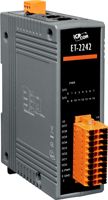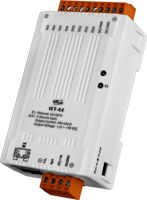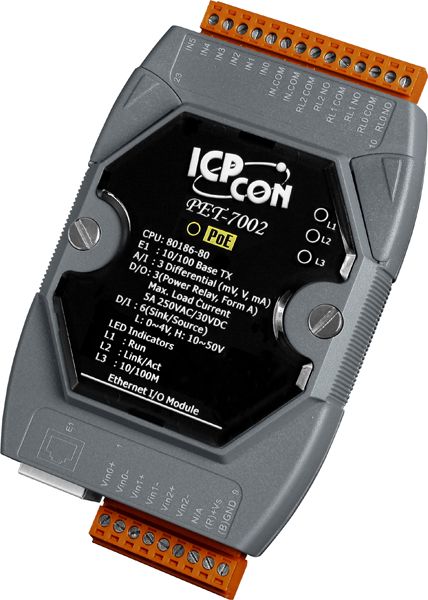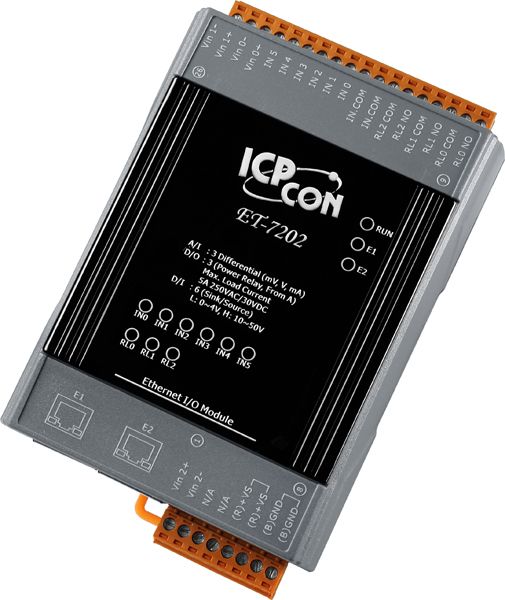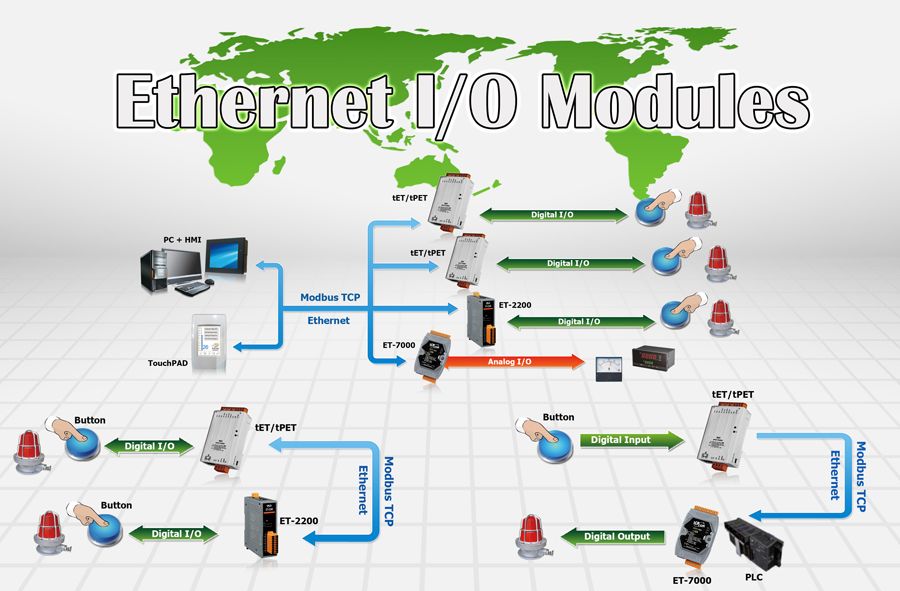
Introduction
Providing networking ability and various digital I/O functions, the tET/tPET/ET-2200 series are IP-based Ethernet I/O monitoring and control modules. The module can be remotely controlled through a 10/100 M Ethernet network by using Modbus TCP/UDP protocol. Modbus has become a de facto standard communications protocol in industry, and is now the most commonly available means of connecting industrial electronic devices. This makes the tET/tPET/ET-2200 series perfect integration with the HMI, SCADA, PLC and other software systems.
Features
1. DIO Pair-Connection (Mirror)
The tET/tPET/ET-2200 series Ethernet I/O modules support various I/O types, like photo-isolated digital input, power relay, PhotoMOS relay, and open collector output. The module can be used to create DI to DO pair-connection (mirror) through the Ethernet. Once the configuration is completed, the modules can automatically read the local DI status and write to remote DO channels via the Modbus TCP protocol in the background.
Push mode is a new way to transfer local DI status, immediately and automatically, to remote device or computer once the DI status changes. Without busy polling, push mode effectively reduces the network loading and improves the performance of the whole system. tET/tPET/ET-2200 series supports both polling and push mode to transfer the I/O data over the network. No programming is required in the tET/tPET series, and the push mode can be easily enabled through the web configuration interface. The solution makes the user set up system easily and quickly, and the system work more efficiently.
Push mode is a new way to transfer local DI status, immediately and automatically, to remote device or computer once the DI status changes. Without busy polling, push mode effectively reduces the network loading and improves the performance of the whole system. tET/tPET/ET-2200 series supports both polling and push mode to transfer the I/O data over the network. No programming is required in the tET/tPET series, and the push mode can be easily enabled through the web configuration interface. The solution makes the user set up system easily and quickly, and the system work more efficiently.

2. Network Configuration
HCP minimizes configuration errors caused by manual IP address configuration, such as address conflicts caused by the assignment of an IP address to more than one computer or device at the same time. The tET/tPET/ET-2200 series module supports the DHCP client function, which allows tET/tPET/ET-2200 to easily obtain the necessary TCP/IP configuration information from a DHCP server. The module also contains a UDP responder that transmits its IP address information a UDP search from the eSearch utility program, making local management more efficient.
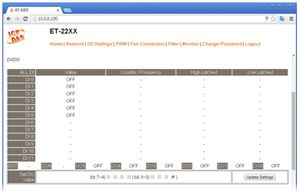
3. Built-in Web Server
The series of Ethernet I/O modules features a powerful 32-bit MCU to enable efficient handling of network traffic. It also has a built-in web server that provides an intuitive web management interface to allow users to modify the settings of the module including DHCP/Static IP, gateway/mask, and serial ports.
4. Built-in Dual Watchdog
The module provides dual watchdog: CPU watchdog (hardware function) and host watchdog (software function). The CPU watchdog which automatically resets the CPU if the built-in firmware is operating abnormally, while the host watchdog sets the digital output with predefined safe-value when there is no communication between the module and the host (PC or PLC) for a period of time (watchdog timeout). The dual watchdog is an important feature that ensures the module operates continuously, even in harsh environments.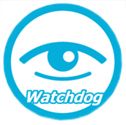
5. PWM (Pulse Width Modulation)
The DOs on the tET/tPET/ET-2200 series provide PWM (pulse generation) function. Users can set different frequency and duty cycle for each digital output channel. In addition, the two DO channels can work independently or simultaneously. The t(P)ET series product reduces the complexity of the control system and enhances the timing accuracy.
6. Frequency Measurement
The tET/tPET/ET-2200 series module also provides the function of the frequency measurement; it gets the DI count in a certain time and calculates the frequency. Rather than polling by the remote host, our module can count out the frequency directly, reduce the communication delay caused by two ends and also increase the accuracy of frequency measurement. In order to apply for more applications, this module provides 3 scan modes and 4 moving average methods for users to select the best way in their applications. This feature can be used for rotation and speed measurements.
7. Daisy-Chain Ethernet Cabling
The ET-2200 series has a built-in two-port Ethernet switch to implement daisy-chain topology. The cabling is much easier and the total costs of cable and switch are significantly reduced.

8. LAN Bypass
LAN Bypass feature guarantees Ethernet communication. It will automatically activate to continue the network traffic when the ET-2200 series loses its power.
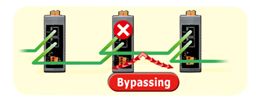
9. Low Power Consumption
The tPET series module offers true IEEE 802.3af-compliant (classification, Class 1) Power over Ethernet (PoE) using a standard category 5 Ethernet cable to receive power from a PoE switch such as the NS-205PSE. If there is no PoE switch on site, the module will also accept power input from a DC adapter. The tET/tPET/ET-2200 series is designed for ultra-low power consumption, reducing hidden costs from increasing fuel and electricity prices, especially when you have a huge amount of device servers installed. Reducing the amount of electricity consumed by choosing energy-efficient equipment can have a positive impact on maintaining a green environment.


10. Convenience
The module is equipped with removable terminal block connectors to allow easy wiring. For maximum space savings, the tET/tPET series is offered in an amazing tiny form-factor while the ET-2200 series is palm-size form-factor; this makes them can be easily installed in anywhere, even directly embedded into a machine.
|
|
||||||||||||
|
Analog Input Modules
|
||||||||||||
| Model | AI | Protocol | ||||||||||
|---|---|---|---|---|---|---|---|---|---|---|---|---|
| Channels | Sampling Rate | Voltage & Current Input | Sensor Input | Channel to Channel Isolation | MQTT | SNMP V2c | ||||||
| ET-2217 | PET-2217 | 8/16 | 20/200 Hz (total channels) |
±150 mV, ±500 mV, ±1 V, ±5 V, ±10 V, ±20 mA, 0 ~ +20 mA, +4 ~ +20 mA | – | – | Yes | |||||
| ET-2217H | PET-2217H | 8 | 8 KHz (total channels, TCP Streaming) |
±2.5 V, 0 ~ +5 V, ±5 V, 0 ~ +10 V, ±10 V, 0 ~ +20 mA, ±20 mA, +4 ~ +20 mA | – | – | Yes | |||||
| ET-2217CI-4 | – | 4 | 10/200 Hz (per channel) |
±1 V, ±2.5 V, ±5 V, ±10 V,±20 mA, | – | Yes | Yes | – | ||||
| ET-2217CI | – | 8 | ||||||||||
| ET-2215H | PET-2215H | 8 | 1.5/90 Hz (per channel) |
– | Pt100, Ni120, Cu50, Cu100 | – | Yes | Yes | ||||
| ET-2215H-16 | PET-2215H-16 | 16 | ||||||||||
| ET-2218H/S1 | PET-2218H/S1 | 8 | 1.5/100 Hz (per channel) |
– | Thermocouple: J, K, T, E, R, S, B, N, C, L, M, LDIN43710 |
– | Yes | Yes | ||||
| ET-2218H-16/S1 | PET-2218H-16/S1 | 16 | ||||||||||
| ET-2218HS-16 | PET-2218HS-16 | 16 | – | Thermocouple: J, K, T, E, R, S, B, N, C, L, M, LDIN43710 Support Standard Thermocouple Connector |
– | Yes | Yes | |||||
|
|
||||||||||||
|
Analog Output Modules
|
||||||||||||
| Model | AO | Protocol | ||||||||||
|---|---|---|---|---|---|---|---|---|---|---|---|---|
| Channels | Resolution | Voltage Output | Current Output | Channel to Channel Isolation | Bus Isolation | MQTT | SNMP V2c | |||||
| ET-2224 | PET-2224 | 4 | 12-bit | 0 ~ +5 V, 0 ~ +10 V, ±5 V, ±10 V |
0 ~ +20 mA, +4 ~ +20 mA |
– | – | Yes | Yes | |||
| ET-2228 | PET-2228 | 8 | ||||||||||
| ET-2224P | PET-2224P | 4 | 16-bit | |||||||||
| ET-2228P | PET-2228P | 8 | ||||||||||
| ET-2224CI | PET-2224CI | 4 | 12-bit | 0 ~ +5 V, 0 ~ +10 V |
Yes | – | Yes | – | ||||
| ET-2228CI | PET-2228CI | 8 | ||||||||||
| ET-2224CIS | PET-2224CIS | 4 | ||||||||||
| ET-2228CIS | PET-2228CIS | 8 | ||||||||||
|
|
||||||||||||
|
Digital I/O Modules
|
||||||||||||
| Model | UDIO | DI | DO | Protocol | ||||||||
|---|---|---|---|---|---|---|---|---|---|---|---|---|
| Channels | Channels | Contact | Sink/ Source |
Channels | Type | Sink/ Source |
Max. Load @ 25゚C | MQTT | SNMP V2c | |||
| ET-2242 | PET-2242 | – | – | – | – | 16 | Open Collector | Sink | 650 mA/Channel | Yes | ||
| ET-2242U | – | – | – | – | – | 16 | Push-Pull | Sink/ Source |
500 mA/Channel | |||
| ET-2242U-32 | PET-2242U-32 | – | – | – | – | 32 | 300 mA/Channel | |||||
| ET-2251 | PET-2251 | – | 16 | Wet/Dry | Sink/ Source |
– | – | – | – | |||
| ET-2251-32 | PET-2251-32 | 32 | ||||||||||
| ET-2254 | PET-2254 | 16 | * | Dry | Source | * | Open Collector | Sink | 100 mA/Channel | |||
| ET-2254P | PET-2254P | 350 mA/Channel | ||||||||||
| ET-2255 | PET-2255 | – | 8 | Wet/Dry | Sink/ Source |
8 | Open Collector | Sink | 650 mA/Channel | |||
| ET-2255-32 | PET-2255-32 | 16 | 16 | 500 mA/Channel | ||||||||
| ET-2255U | PET-2255U | – | 8 | 8 | Push-Pull | Sink/ Source |
||||||
| *Note: The number of DI/DO channels is depending on wiring and the software configuration. | ||||||||||||
|
|
||||||||||||
|
Relay Output/Digital Input Modules
|
||||||||||||
| Model | DI | DO | Protocol | |||||||||
|---|---|---|---|---|---|---|---|---|---|---|---|---|
| Channels | Contact | Sink/Source | Channels | Relay | Sink/Source | Max. Load @ 25゚C | MQTT | SNMP V2c | ||||
| ET-2260 | PET-2260 | 6 | Wet/Dry | Sink/Source | 6 | Power Relay | Form A (SPST N.O.) | 5 A @ 250 VAC/24 VDC (Resistive Load) |
Yes | |||
| ET-2261 | PET-2261 | – | – | – | 10 | |||||||
| ET-2261-16 | – | – | – | – | 16 | |||||||
| ET-2268 | – | – | – | – | 8 | Signal Relay | 4 Form A, 4 Form C |
2 A @ 30 VDC 0.25 A @ 250 VDC |
||||

